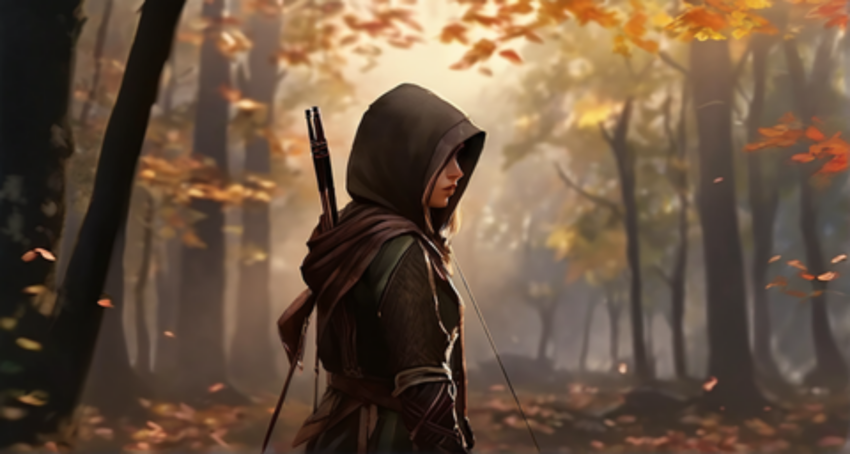We wrote a whole article last year about how writers can generate suspense even when their audience knows exactly what happens next. But while stories where life and death hang in the balance can generate suspense even when the readers know what happens next, many stories are scattered with far less important, much smaller twists that add interest and unpredictability to the plot. In these cases, the balance between suspense and surprise isn’t equal, and suspense simply can’t deliver the emotional impact that an unexpected (albeit smaller) plot twist can.
So today we’re going to dive into not only what makes deceiving your readers important, but also how to do it well by looking at the young adult fantasy novel Rowan Hood.
Rowan Hood
Rowan is the 13-year-old daughter of the outlaw Robin Hood, whom she has never met. Raised by her magically-gifted mother in a cottage just outside the village, Rowan is considered an outsider everywhere she turns. The village won’t accept her because of her mother’s magic, the outlaws don’t see her as an equal because she has a home, and in some ways she feels estranged from her own mother because of her inability to cast spells.
Rowan’s world is shattered when her mother is accused of witchcraft and their cottage is set ablaze, killing her mother and leaving Rowan without protection or a home in a world where she already feels like an outlaw. Deciding her only hope is to track down her father and join his band, she disguises herself as a boy and travels toward Sherwood forest, with a wolf-like dog as her only companion.
Finally, after weeks of travel through the woods, Rowan is convinced she is close to her father’s hideout. Making her way through the woods one morning, she is jerked to attention when an arrow flies toward her dog, who pulls it from the air like a toy.
Rowan whirls around, nocking her bow in a single motion and facing the outlaw who attacked her dog. She is surprised by his old eyes and youthful face as he explains he thought her dog was a wolf attacking her. Throughout their conversation, Rowan takes in his tall stature, his witty comeback to every prying question, and how easily he navigates the woods. She can’t get any information from him except that he’s part of Robin Hood’s band, but that’s good enough for her.She finally convinces him to guide her to Robin Hood’s camp, and when they arrive, his men greet Rowan and the outlaw, calling him “Robin” and laughing at Rowan.
And the chapter ends with the not-too-surprising reveal that the outlaw Rowan met in the woods was actually her father.
Subtext
The truth is that even without explicitly stating information, readers often pick up subtext and clues within writing to tell the direction of a story or the purpose of an event. Most readers are at least subconsciously aware of themes, plot structures, and the direction of a character arc. That means withholding information about these sorts of things can be extremely difficult, and if it isn’t done intentionally, can end up making a pretty thinly-veiled mystery. Even though the author concealed Robin’s name and didn’t give any intentional hints to his identity, by the way she described him, the readers could easily tell the outlaw was meant to be an important character. When he refused to give his name and evaded any questions about his identity, it became clear that he was her father, Robin Hood.
While it’s important to be able to write suspense that is engaging whether or not the reader knows the outcome, there are times when that isn’t possible. And when you’re writing these little mini mysteries to keep your readers on their toes, it’s important to make sure your subtext isn’t revealing more than you want it to. These little reveals and mini secrets scattered throughout a story become an extra level of interest and make your plot seem even more clever. They can keep your readers on edge throughout the entire story (even when there isn’t a plot twist coming) because the readers aren’t sure when to expect another plot twist — and what actually is as it seems.
It also makes your story seem far more believable. Since we as readers live in a reality where we have very little idea what happens next and don’t have a plotline to give us hints or an author to write in subtext, we often have no idea what’s to come. Things are consistently not as they seem, and people, places, and events continue to surprise us or fail to fit into our expectations. So when readers can pick up a book and tell exactly what happens next, the events start to feel contrived — even if they aren’t.
The key to writing these little mysteries is to approach them from the perspective of what you want your reader to think, or what you imagine your reader will assume. Instead of asking yourself “What would my character think about this situation?” ask yourself, “How would I write about this situation?” In this case, rather than going into detail about how Robin walks and talks and his witty mocking, the author should have introduced him as she would have any other outlaw — the same way that she introduces the less-important outlaws we meet in the very next chapter.
Once you immerse yourself in the perspective of the lie you want your readers to assume is true, it becomes fairly simple to avoid telling subtext, because you are subconsciously writing in subtext that points to the illusion you want your readers to fall for — the mirage you want them to focus on instead of the reality you haven’t yet denied but don’t want them to consider.
The thing with these little mysteries is that the moment the idea occurs to your readers, they’ll likely figure out pretty quickly what you’re trying to keep from them. Whether you’re introducing the secret heir to the throne, allowing your protagonists to meet the culprit behind your mystery, or concealing a part of a character’s backstory that keeps haunting them, even having a character mention the reality as a joke is usually enough for your readers to figure out what they’re missing.
These sorts of things are delicate, and so the best way to write them is from a completely different perspective. Immerse yourself in a version of the story where that character isn’t the heir, where their next-door neighbor isn’t the culprit, or where the first outlaw Rowan meets isn’t her father. Look at the story from that perspective. Ask yourself what words you would use, how much you would describe, and how your character would think through the circumstances around them. Consider what would change even in the dialogue and style of the scene — and you’ve found the subtext that would have given your reveal away.
This technique is one that’s easy to understand and can be difficult to execute. Often it means introducing a character completely differently than you’d planned, to mislead both your readers and the other characters. Other times it means cutting much-needed description to make an event seem as though it isn’t all that important. In other cases it involves not letting your character crack a joke or postulate about the truth before it’s revealed.
Like with everything, this technique is a trade-off. And it can be worth evaluating whether or not it’s worth it to have a little jolt of surprise for your readers when instead you could write an awesome character introduction, include a beautiful description, or make your readers roar with laughter at a joke. Just be conscious of those decisions and don’t play off the reveal like it’s supposed to be a shocking secret when you have clearly hinted at it and possibly even made the truth obvious to your readers, even if it’s still hidden to your characters.
But if you do choose to use this technique, it becomes an indispensable way to hide the truth from your readers. If you’re writing a mystery or a thriller, this is definitely a tool that should be in your toolbox. When both what you say and what you don’t point to a lie, your readers will have a hard time guessing the truth that you can conceal for as long as you’d like — until it’s time to shock both your characters and your readers with a twist they could never see coming.



Let us know in the comments:
Have you tried to deceive your readers? Have you noticed this technique used in other stories?


Hi! My name is Mara, and I’m a Christian artist, violinist, and blogger. I remember the day that I decided that I would learn something new about what makes a good story from every book I picked up — whether it was good, bad, or a mixture of both. I use this blog as a way of sharing some of the tips and tricks I’ve learned, and highlight which books, cartoons, and movies have taught me the most about writing an awesome story.

